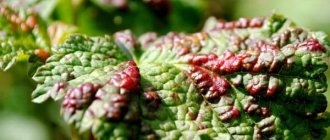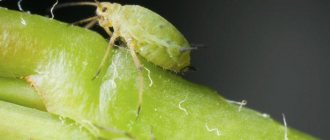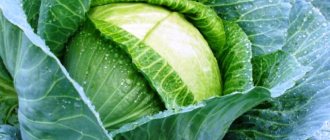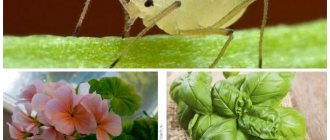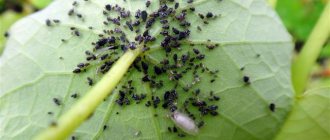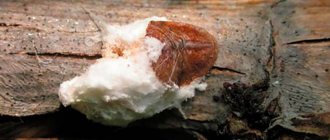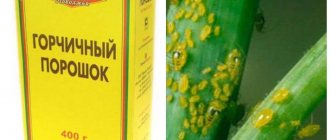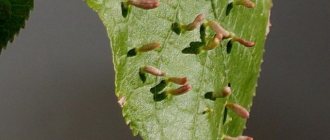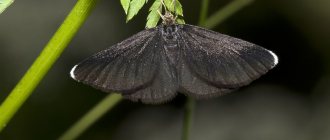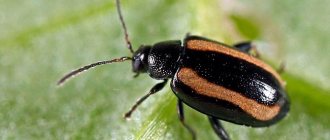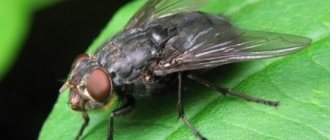The article describes the problem of aphids on cherries: how to get rid of them using chemical and folk remedies. How to recognize, preventive measures.
It so happened historically that by growing delicious berries, juicy vegetables or beautiful flowers, we unwittingly provide food for many harmful insects. By damaging leaves and stems, gnawing roots, and feeding on plant sap, they can significantly affect productivity and cause the death of flowers, vegetable crops, bushes and trees. Aphids on cherries, despite their small size, are very dangerous, since by sucking out the juice, the insects completely dehydrate the plant, it withers and may die. Therefore, it is necessary to regularly inspect the trees for the appearance of aphids on the cherry and, if detected, immediately begin the fight. Watching the stunningly beautiful flowering of cherry trees, you were anticipating cherry compotes and jam, and then you noticed that all the foliage was covered with a sticky coating, began to curl and wither. So what to do in such a situation?
Description of black aphids
Aphids are insects from the genus Hemiptera. Cherries, plums and other stone fruits are attacked by black aphids. These are small creatures that reach a size of no more than a couple of millimeters. The body shape of an insect is always different.
Aphids can be both wingless and winged. The wingless type of insect does not leave its habitat and constantly reproduces there. One individual insect can produce 4-5 generations of offspring within a couple of months. The number of individuals reaches several hundred thousand, which constantly reproduce. In summer, 10-12 generations can be born.
Aphids are attracted to cherries by their juice. They extract it from the plant by piercing the surface of the shoots with their proboscis. Aphids prefer the juiciest plants for food; it is easier to get food from them. Black aphids infect the bases of leaves and tops of shoots.
The winged subspecies spreads aphids to other plants. It is not born in every generation, but only when the colony becomes too large for one plant. Also, winged aphids appear during cold weather and other unfavorable conditions.
During feeding, aphids secrete sweet honeydew, which attracts other garden insects. Bees use honeydew to create honeydew honey. The main lovers of the sweet substance are ants. They become a kind of protectors of aphids. Ants protect aphids from other insects and transfer them to other plants.
Why is it dangerous for trees?
This family of insects is quite a nasty pest. Settling on the underside of leaves, aphids suck juices from fresh green plants, destroying young shoots. At the same time, it secretes poison, which causes the leaves to curl, change shape and die, the shoots do not grow, and the tops become bent. Aphid waste - sweet secretions - contaminates the leaves, thereby disrupting the natural life of the plant. She also spreads viral infections through her saliva. Among fruit trees, the greatest damage occurs to young seedlings. Aphids are familiar small insects up to 7 mm. They have a special piercing-sucking proboscis, which they use to pierce the surface of leaves, buds or new shoots and suck out the juice. The plant is greatly weakened and becomes susceptible to viral diseases. Some species of aphids damage plant roots. Aphids come with wings and without wings. Some fly away with the wind up to 25 km, while others reproduce locally 2 times a year, in spring and summer. The excrement excreted by aphids contains a lot of carbohydrates; ants love this special treat.
Ants carry aphid larvae over considerable distances to succulent parts of the plant, protecting them from bad weather even in their anthill. It is ants in symbiosis with larvae, winged and wingless representatives of aphids that can cause great trouble in your garden.
The insects adapted to seasonal changes and studied the physiology of the plant they liked. They reproduce in two ways: the first is natural mating of males and females, and the second method is viviparity of virgin females. Aphids are a dangerous insect and must be combated in spring and autumn. In the fall, females lay eggs that overwinter on trees and shrubs and hatch into wingless females.
Ants carry such wingless creatures from tree to tree. In May, winged females appear, capable of migrating over distances that will give birth to males and females in September. They are fertilized again and this process is endless, which once again proves the complexity of combating this type of pest.
The aphid's diet is enormous; it feeds on fruits on apple, pear, quince, plum, medlar, hawthorn, serviceberry and dogwood trees. It multiplies and therefore harms sunflower, thistle, chamomile, thistle, and comfrey. There are lovers of flower plants - roses, meadowsweet, tulips, black currants, viburnum. There are 450 species of aphids in our hemisphere.
Obviously, without taking special measures to destroy these pests, enormous damage will be caused to the garden and the entire area.
The fight against aphids is further complicated by their rapid reproduction.
In addition to methods of getting rid of aphids, which we will consider later in our article, you need to pay attention to preventive measures
Reasons for the appearance of black aphids on cherries
Before you fight aphids on cherries, you need to pay attention to the causes of tree infestation. The main reasons for cherry aphid infestation are:
• a large number of weeds around the tree; • colonies of ants living nearby; • weak plant immunity.
An unkempt garden with a lot of weeds will quickly lead to the appearance of various diseases. Winged aphids can reproduce on weeds in early spring, and then transfer their relatives to cherries in June, when cherries are in fruiting period.
Aphid colonies would not be able to develop quickly without the ants. The wingless aphid would be destroyed by other insects or would die from lack of food. Winged aphids reproduce poorly and would not be able to restore the colony. The wingless subspecies cannot move normally around the plant without ants.
Cherry shoot moth (Argyrestia pruniella)
This small insect cannot be detected immediately in the garden, since its dimensions do not exceed 5 mm, with a wingspan of 12 mm. Successfully overwintered caterpillars bite into the buds that are beginning to bloom, causing their death or the appearance of underdeveloped and ugly leaves. Subsequently, the caterpillars move to the blossoming shoots and eat away the stamens and pistils. At the site of the ovary, a lump of cobwebs with small dry excrement remains.
The first caterpillars (they are yellowish-green with a brown head) can be found in early spring. During the period of growth and development, one caterpillar can damage 5-7 buds. At the end of June - beginning of July, butterflies emerge from the pupae, whose flight continues until the end of summer. During the day they hide on the underside of leaves, less often on trunks and branches. Towards the beginning of September, butterflies lay eggs (up to 30 pieces) on or near the buds of trees.
Measures to combat cherry shoot moth:
Damage from black aphids on cherries
The action of the pest leads to the following negative consequences:
• infestation by aphids can lead to the death of the tree; • plants have an increased chance of being infected by various viruses; • yields are significantly reduced; • berries become small and ugly; • the possibility of infection of all neighboring plants.
Black aphids can infect currants, gooseberries, raspberries and other neighboring plants. The insect can also harm plums, apricots and other stone fruits. The pest feeds on plant sap, which disrupts the flow of nutrients into the leaves. They dry out and curl, and the affected surface turns black.
There is a risk of getting infected from black aphids. Various fungal diseases can develop on the shoots. Along with insect saliva, various microorganisms enter the cells. Sooty fungus can lead to crop loss, and if the tree is not cured before winter, it will die.
Major pests
- Aphids - suck juices from leaves. This causes the leaves to dry out and fall off, because the food supply stops and all the juice is lost to aphids
- The plum moth is a large moth that lays its eggs right inside green fruits. Caterpillars hatching from eggs devour fruits
- The larvae of the cockchafer usually overwinter in the soil under the roots of a tree, simultaneously devouring them. This leads to the fact that young shoots die and the old tree begins to weaken
- Sapwood - eat young wood under the bark between the branches and buds. Nutrients stop flowing, branches die
- Weevils - feed on swollen buds or seeds of already formed fruits. It happens that the weevil manages to destroy the entire crop.
- Hawthorn caterpillar - eats all above-ground parts of the tree. Flowers stop pollinating, fruits do not form
How to deal with aphids on cherries
When black aphids appear on cherries, how to get rid of the pest must be decided as quickly as possible. An integrated approach to treatment will help to completely remove aphids and save cherries.
The fight against the parasite is carried out using the following methods:
• regular weeding of the soil to remove weeds; • destruction of cherry shoots; • timely application of fertilizing and fertilizers; • use of chemical and biological agents; • preventive treatment; • attracting insects to the cherry that feed on aphids.
Chemicals to control aphids
Among the most effective ways to treat cherries against aphids are the following:
• Karbofos; • Fufan; • Arrivo.
These are fast-acting contact agents. They penetrate the insect through the outer cover. This treatment leads to the death of parasites.
The fight against aphids on cherries is also carried out with intestinal and systemic drugs. These methods of control can quickly rid cherries of aphids. The substances enter the insect's body when it eats.
The following preparations will help remove aphids from leaves:
1. Aktara. The product is absorbed into the plant tissue, after which it is effective for 14 days. The active ingredient is thiametoscam. 2. Actedylic. The drug is an insecticide that contains pirimiphos-methyl. 3. Inta-vir. The active ingredient is cypermethrin. 4. Confidor. Insecticide containing imidacloprid. The duration of action of the drug is very long.
Treatment with pesticides should be carried out at least a month before picking berries. Preparations can be used at the beginning of summer or after flowering has ended; this can destroy aphids that have just attacked. It is important not to treat with insecticides during flowering, as this will lead to the death of bees. For prevention, you can apply the product 20 days before the flowers appear.
Cherry weevil
In early spring, when the snow has melted but the buds have not yet awakened, cherry weevils can be manually shaken off onto improvised materials spread under the trees, collected and burned. This method is convenient if low-growing varieties grow in hell, but is completely unsuitable when the pest threatens large trees 5–7 meters high.
Therefore, a more competent and long-term way is to install fishing belts. They will protect the plantings not only immediately, but also throughout most of the summer.
When attacked by weevils, chemical means of protection, as well as traditional methods, are used. How to spray cherries against pests in this case? Modern insecticides, which are used to irrigate crowns, trunks and tree trunks, help against beetles. Treatment is carried out early, after flowering and in the fall, after leaf fall.
In addition, cherries can be treated with a daily infusion of fragrant or chamomile. A bucket of hot water will require 100 grams of plant material and half a bar of crushed laundry soap.
Biological agents to combat aphids
Aphids on leaves can be destroyed using insecticides that contain toxic substances of biological origin. Cherries are processed with the following preparations:
• Aktofit; • Phytofarm; • Nemabact; • Anthonem-F.
The first 2 products contain avermectins, which are products of fungal synthesis. Nemabact and Eetonema use predatory microorganisms that feed on parasite eggs.
You can control pests with biological means even during the growing season. The preparations are much weaker than chemical ones, which allows you to pick berries just a few days after use. Such preparations do not remain on the leaves for a long time and do not pose a danger to bees.
Morphologically related species
In terms of external characteristics (morphology), Myzus formosanus and Myzus dycei are close to the described species:
- Wingless individuals of Myzus formosanus. The tubes are no longer than the tail and are not curved towards the apex. The abdominal tergites are not sclerotized, sometimes with brown, unevenly distributed spots. The color of the integument is light brown and brownish-red. They develop on knotweed.
- Flightless individuals of Myzus dycei. The tubes are 3–3.5 times longer than the tail, curved outward at the apex. The abdominal tergites are sclerotized, wrinkled, and not covered with spots. The color of the integument is light or yellow-green. They develop on nettles.
Traditional methods of fighting aphids on cherries
To combat aphids, you can make various solutions yourself. Folk remedies for combating aphids should be positioned only as an auxiliary treatment. Treatment should be carried out using a comprehensive method.
One of the most popular means is soap solution. If you spray this liquid on a tree, the number of insects will be significantly reduced. To create the product you will need 200 g of crushed laundry soap, which must be diluted in 2 liters of water. To enhance the effect, you can add 100 g of ash. After complete dissolution, you need to spray the tree.
Aphids do not tolerate garlic well, so it is recommended to make an infusion from it. To create it, you need to chop the head of garlic and place it in water. The product should steep for 4-6 days, after which the infusion is filtered and diluted with water. For 5 liters you need 30 g of solution.
You can prepare a solution based on iodine. One bottle must be diluted in 1 liter of water. This solution can also be sprayed on currants, raspberries, strawberries, etc. For effectiveness, you can add a little milk to the liquid.
Winter moth (Operophtera brumata
When the season is over and the harvest is harvested, a very dangerous and insidious enemy flies to the plots - the winter moth. Owners of dachas located near forests or other tree plantations should be especially wary of it. If in September-October you notice nondescript light brown or beige moths, know that it is too early to leave the area.
The wingspan of an adult moth does not exceed 25 mm. The front wings are gray-brown with dark wavy transverse lines, the hind wings are slightly lighter. Caterpillars are up to 28-30 mm long, yellow-green, with a longitudinal brown stripe on the back and a yellow-brown head. They appear approximately 10-14 days before flowering and feed on leaves and other parts of the plant. Caterpillars gnaw out buds, flowers and ovaries, entwining them with cobwebs. A month later, the insects descend into the ground and pupate, remaining in this state until autumn. In September-October, butterflies emerge from the pupae, for which a temperature of 5-11°C is considered favorable. They are not afraid of even night frosts down to –15°C! Adult females lay eggs near the buds, in cracks or folds of the bark, and can lay up to 300 eggs in the fall.)
Measures to combat winter moth:
Using food to control aphids on cherries
You can fight aphids on cherries with Coca-Cola. This drink contains phosphoric acid, which kills pests. The cola should be diluted with water in a ratio of 1 to 1 and the solution should be sprayed on the affected tree.
Baking soda can kill aphids. It is necessary to dissolve 10 g of soda in 1 liter of water and treat the cherries. This method is effective at any stage of infection.
To combat parasites I use dry mustard. For 1 liter of water you need to take 100 g of mustard in powder form and mix everything. Both aphids and ants dislike the mustard scent. After treatment, they begin to quickly leave the plant. To enhance the effect, you can add a little liquid soap to the solution.
Herbal infusions and decoctions
There must be a “garden pharmacy” on every site or beyond. These are plants that repel aphids and other pests. Gardeners have long known recipes for infusions and decoctions from available wild and garden crops.
Tobacco
The infusion is prepared in this ratio
- 40 g of crushed fresh leaves for every liter of water.
Pour water over the tobacco and leave for two days. Before use, strain the infusion and add water 1:2.
According to another recipe, an infusion can be prepared from dry tobacco dust. You will need half a glass. The powder is poured into a liter of water and boiled for 0.5 hours. The broth is infused for two days in a dark place. After 2 days, you can filter it and add 2 liters of water. At this concentration it is ready for use.
Photo 4. Tobacco dust is a well-known insecticidal agent against aphids and other pests.
Elderberry
Our ancestors planted bushes near the house to repel annoying insects. Modern experts call this plant a natural insecticide. The specific smell of elderberry is not to the liking of ants and aphids. Even if it is not in your garden, you can find it in a forest or park and make an infusion from it:
- Pour 1 kg of young leaves (crushed) into 10 liters of water and leave for 12 hours. To process cherries, the infusion must be strained.
For infusion, you can use dry raw materials. It is prepared from inflorescences and dried in the shade.
To prepare the insecticide, you need 200 g of chamomile per 10 liters of water, leave for 12 hours.
The filtered cake can be filled again, but with a smaller volume of water - 5 liters.
Photo 5. Pyrethrum is sold in garden stores. It is produced in the form of a dry powder.

